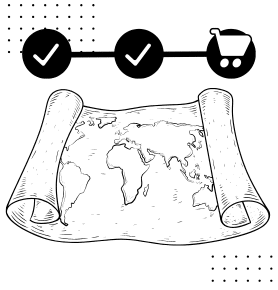Take a Deeper Dive Into the WHY Behind Shopping Cart Abandonment
September 4, 2025

This holiday season, millions of online shopping carts will be left behind. If you own an online shopping cart, every abandoned cart means lost revenue for you. But more important than that, there’s a human story underneath it all that needs to be understood.
About 20 miles east of Vernal, Utah, you find yourself standing on the edge of Carnegie Quarry, a paleontological excavation site. At first glance, plain rocks surround you. As you dig, you might uncover a well-preserved bone that tells the story of an Apatosaurus, thousands of years old. Paleontologists know that every rock face might be hiding something remarkable.
Your customers’ online shopping behavior works the same way. On the surface, shopping cart abandonment looks like a flat statistic. You shrug it off as something that comes with the terrain, but really, it’s just the rocks on the surface.
If you want to understand WHY carts get abandoned, especially in the high-stakes holiday shopping season, take up a shovel and start getting past the superficial layer. Behind every abandoned cart is a human being. While humans back out of purchases for mechanical reasons, they also retreat because of feelings – loss aversion, decision fatigue, regret, or fear.
Put on your bucket hat and slather on some sunscreen. Let’s dig a little deeper into these layers.

Layer One: The Map Everyone Uses For Shopping Cart Abandonment
In preparing for this article, I asked ChatGPT to “Give me the top ten reasons why most online shopping carts are abandoned.” I got some solid responses as a starting point. When I cross-checked the research, the top five articles on cart abandonment sounded eerily alike. (I think they all cited the same AI-generated answers – verbatim. That’s a problem, but that’s a conversation for another day.)
When I asked for the top reasons why shoppers abandon online shopping carts, I was told:

“Unexpected costs, too many steps, lack of payment options, site glitches.”
Each of these hurdles plays a role in cart abandonment. At the bare minimum, your tech should function properly. In fact, your tech should work so well that it’s invisible. Your customers don’t even notice it. If you have a tech issue, the JamboJon help desk can get you up and running again.
While AI can spit out a list of surface answers, there’s more beneath the surface. Once you patch up your tech, what are the emotions that prevent conversions?

Layer Two: The Emotions Below the Surface
As we dig below the surface, let’s turn over the emotions we uncover:
1. Loss Aversion
Humans fear losing more than they love winning. If your customer gets saddled with surprise shipping fees at checkout, they feel like something’s been taken from them. That’s not just an added cost – that’s a betrayal. Emotionally, they feel nickel-and-dimed.
2. Decision Fatigue
The holiday season already burdens customers with choices. Add 10 more form fields, a dropdown with 30 shipping options, or three different upsells, and suddenly, the process feels too hard. Your customers ask themselves if they’re doing something wrong. Emotionally, they feel overwhelmed.
3. Fear of Regret
Shoppers hesitate because they worry. Their carefully chosen gift needs to be the perfect choice for their loved one. On top of that, it should be the right size, the right material, and the right price point. But what if it’s not? That hesitation stalls the momentum. Emotionally, they feel trapped.
4. Distracted Wanderlust (a twist on FOMO)
Without urgency, people wander. A phone buzzes, another tab pops up, or they think, “I’ll check for a better deal.” Suddenly, the cart is abandoned like an artifact left half-buried. Emotionally, they feel indifferent or distracted.
5. Lack of Trust
If the site feels unsafe – poor design, no visible security, vague return policies – customers hesitate. It’s like stepping onto a rope bridge that creaks too loudly. Emotionally, they feel unsafe.

Layer Three: Address the Emotions, Not Just the Cart

Now that you’ve unearthed the deeper emotions, what do you do with that knowledge? Said a recent article:
Here are three ways to “get into the customers’ heads.” Respond to the psychology of the negative emotions, not just to the technical mechanics of checkout:
1. Address the Feeling of Being “Nickel-and-Dimed”
Hidden shipping, taxes, and fees trigger loss aversion. At this point, your customers feel like they’ve already shaken hands with you on a screaming deal. You’re about to pass them their items, but you yank the bag away and thrust out your hand until they cough up a little more.
How to Fix It:
- Be radically transparent with costs from the start.
- Offer free or flat-rate shipping thresholds (“Spend $50 for free shipping”).
- Frame shipping positively (“Fast, secure delivery right to your door”).
2. Simplify to Reduce Overwhelm
Endless forms, options, and upsells wear your customers out. “One more thing” turns into multiple, time-consuming items on the to-do list. Decision fatigue makes your customers quit – not because they don’t want the product, but because the process feels too clunky.
How to Fix It:
- Streamline forms to the bare essentials (name, address, payment)
- Offer guest checkout
- Save progress automatically, so they don’t have to start over if distracted
- Limit upsells
3. Build Safety and Trust Into the Path
Uncertainty about returns, security, or reliability sparks hesitation. They’re not wrong. “The U.S. Federal Trade Commission (FTC) received more than 1.1 million complaints of identity theft in 2024 and roughly 2.6 million complaints of related fraud for the same period, resulting in total financial losses that totaled more than $12.7 billion.” A healthy dose of skepticism keeps people safe. Fear of regret makes your shoppers freeze.
How to Fix It:
- Display trust badges, reviews, and clear refund policies upfront.
- Use plain language instead of legal jargon for return policies
- Offer reassurance cues like “Easy 30-day returns” or “Secure payment guaranteed.”
- Please make sure everything about your checkout process is as secure as it can be.

What We Learn From the Emotional Artifacts:
Every abandoned cart holds an emotional story. The holidays heighten these feelings. Stress levels run higher, wallets feel tighter, and expectations stretch bigger. Show customers that you understand what they feel and that you’ve anticipated their worries.
Think of every abandoned cart as a buried clue – not a lost sale. Each tells you what your customers fear, what overwhelms them, and where they lost trust. The more you listen, the more you learn.
Like an archeologist uncovering valuables, you must pay attention. Dig deeper. Brush away everything else and focus on what lies beneath your customers’ actions. When you do, you’ll see that human beings are trying to fill a need. It’s your job to figure out what that is.
















